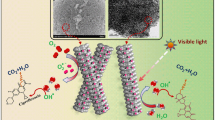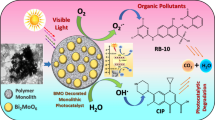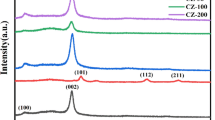Abstract
This work reports a unique ZrO2–Ag2O heterojunction nanocomposite uniformly dispersed on a macro-/meso-porous polymer monolithic template to serve as simple and effective visible light-driven heterogeneous plasmonic photocatalysts for water decontamination. The monolithic photocatalysts' structural properties and surface morphology are characterized using various surface and structural characterization techniques. The photocatalytic performance of the proposed photocatalysts is evaluated by optimizing multiple operational parameters. The photocatalytic properties of the fabricated monolithic nanocomposite are monitored through time-dependent photocatalytic disintegration of norfloxacin drug, a widely employed antimicrobial, with considerable aquatic persistence. The analytical results conclude that a (60:40) ZrO2–Ag2O nanocomposite embedded polymer monolith exhibits superior photocatalytic activity for the complete mineralization of norfloxacin molecules under optimized conditions of solution pH (3.0), photocatalyst quantity (100 mg), pollutant concentration (15 mg/L), photosensitizers (2.0 mM KBrO3), visible light intensity (300 W/cm2 tungsten lamp) and irradiation time (≤ 1 h). The proposed new-age inorganic–organic hybrid visible light photo-catalysts with superior structural and surface properties exhibit brilliant performance and fast responsiveness for water decontamination applications, in addition to their excellent chemical stability, high durability, multi-reusability, and cost-effectiveness.
Graphical abstract







Similar content being viewed by others
References
Rong, F., Lu, Q., Mai, H., Chen, D., & Caruso, R. A. (2021). Hierarchically porous WO3/CdWO4 fiber-in-tube nanostructures featuring readily accessible active sites and enhanced photocatalytic effectiveness for antibiotic degradation in water. ACS AppIied Materials & Interfaces, 13, 21138–21148. https://doi.org/10.1021/acsami.0c22825
Yan, D., Hu, H., Gao, N., Ye, J., & Ou, H. (2019). Fabrication of carbon nanotube functionalized MIL-101(Fe) for enhanced visible-light photocatalysis of ciprofloxacin in aqueous solution. Applied Surface Science, 498, 143836. https://doi.org/10.1016/j.apsusc.2019.143836
Li, N., He, M., Lu, X., Liang, L., Li, R., Yan, B., & Chen, G. (2021). Enhanced norfloxacin degradation by visible-light-driven Mn3O4/γ-MnOOH photocatalysis under weak magnetic field. Science of the Total Environment, 761, 143268. https://doi.org/10.1016/j.scitotenv.2020.143268
Wang, F., Gao, J., Zhai, W., Cui, J., Liu, D. Z., Zhou, Z., & Wang, P. (2021). Effects of antibiotic norfloxacin on the degradation and enantioselectivity of the herbicides in aquatic environment. Ecotoxicology and Environmental Safety, 208, 111717. https://doi.org/10.1016/j.ecoenv.2020.111717
Fang, N., He, Q., Sheng, L., Xi, Y., Zhang, L., Liu, H., & Cheng, H. (2021). Toward broader applications of iron ore waste in pollution control: Adsorption of norfloxacin. Journal of Hazardous Materials, 418, 126273. https://doi.org/10.1016/j.jhazmat.2021.126273
Chen, X., Zhuan, R., & Wang, J. (2021). Assessment of degradation characteristic and mineralization efficiency of norfloxacin by ionizing radiation combined with Fenton-like oxidation. Journal of Hazardous Materials, 404, 124172. https://doi.org/10.1016/j.jhazmat.2020.124172
Sayed, M., Shah, L. A., Khan, J. A., Shah, N. S., Nisar, J., Khan, H. M., Zhang, P., & Khan, A. R. (2016). Efficient photocatalytic degradation of norfloxacin in aqueous media by hydrothermally synthesized immobilized TiO2/Ti films with exposed (001) facets. Journal of Physical Chemistry: A, 120, 9916–9931. https://doi.org/10.1021/acs.jpca.6b09719
Behera, A., Kandi, D., Sahoo, S., & Parida, K. (2019). Construction of isoenergetic band alignment between CdS QDs and CaFe2O4@ZnFe2O4 heterojunction: A promising ternary hybrid toward norfloxacin degradation and H2 energy production. Journal of Physical Chemistry C, 123, 17112–17126. https://doi.org/10.1021/acs.jpcc.9b03296
Alnajrani, M. N., & Alsager, O. A. (2020). Removal of antibiotics from water by polymer of intrinsic microporosity: Isotherms, kinetics, thermodynamics, and adsorption mechanism. Scientific Reports, 10, 1–14. https://doi.org/10.1038/s41598-020-57616-4
Baaloudj, O., Assadi, I., Nasrallah, N. A., El Jery, A., Khezami, L., & Assadi, A. A. (2021). Simultaneous removal of antibiotics and inactivation of antibiotic-resistant bacteria by photocatalysis: A review. Journal of Water Processing Engineering, 42, 102089. https://doi.org/10.1016/j.jwpe.2021.102089
Yang, X., & Wang, D. (2018). Photocatalysis: From fundamental principles to materials and applications. ACS Applied Energy Materials, 1, 6657–6693. https://doi.org/10.1021/acsaem.8b01345
Kampouri, S., & Stylianou, K. C. (2019). Dual-functional photocatalysis for simultaneous hydrogen production and oxidation of organic substances. ACS Cataysis, 9, 4247–4270. https://doi.org/10.1021/acscatal.9b00332
Mohan, H., Ramasamy, M., Ramalingam, V., Natesan, K., Duraisamy, M., Venkatachalam, J., Shin, T., & Seralathan, K. K. (2021). Enhanced visible light-driven photocatalysis of iron-oxide/titania composite: Norfloxacin degradation mechanism and toxicity study. Journal of Hazardous Materials, 412, 125330. https://doi.org/10.1016/j.jhazmat.2021.125330
Zhou, S. L., Zhang, S., Liu, F., Liu, J. J., Xue, J. J., Yang, D. J., & Chang, D. J. (2016). ZnO nanoflowers photocatalysis of norfloxacin: Effect of triangular silver nanoplates and water matrix on degradation rates. Journal of Photochemistry and Photobiology A: Chemistry, 328, 97–104. https://doi.org/10.1016/j.jphotochem.2016.03.037
Zhao, Y., Liang, X., Hu, X., & Fan, J. (2021). rGO/Bi2WO6 composite as a highly efficient and stable visible-light photocatalyst for norfloxacin degradation in aqueous environment. Journal of Colloid and Interface Science, 589, 336–346. https://doi.org/10.1016/j.jcis.2021.01.016
Li, J., Xia, Z., Ma, D., Liu, G., Song, N., Xiang, D., Xin, Y., Zhang, G., & Chen, Q. (2021). Improving photocatalytic activity by construction of immobilized Z-scheme CdS/Au/TiO2 nanobelt photocatalyst for eliminating norfloxacin from water. Journal of Colloid and Interface Science, 586, 243–256. https://doi.org/10.1016/j.jcis.2020.10.088
Chen, M., & Chu, W. (2012). Degradation of antibiotic norfloxacin in aqueous solution by visible-light-mediated C-TiO2 photocatalysis. Journal of Hazardous Material, 219, 183–189. https://doi.org/10.1016/j.jhazmat.2012.03.074
Khan, I., Saeed, K., & Khan, I. (2019). Nanoparticles: Properties, applications and toxicities. Arabian Journal of Chemistry, 12, 908–931. https://doi.org/10.1016/j.arabjc.2017.05.011
Fischer, H. C., & Chan, H. C. (2007). Nanotoxicity: The growing need for in vivo study. Current Opinion in Biotechnology, 18, 565–571. https://doi.org/10.1016/j.copbio.2007.11.008
Goswami, L., Kim, K. H., Deep, A., Das, P., Bhattacharya, S. S., Kumar, S., & Adelodun, A. A. (2017). Engineered nano particles: Nature, behavior, and effect on the environment. Journal of Environmental Management, 196, 297–315. https://doi.org/10.1016/j.jenvman.2017.01.011
Toshikj, N., Politakos, N., Veloso, A., De San Román, E. G., Cordero-Lanzac, T., Qin, Z., Leal, G. P., & Tomovska, R. (2020). Visible-light photocatalysts based on manganese doped TiO2 integrated within monolithic reduced graphene oxide/polymer porous monolith. Chemistry Select, 5, 5873–5882. https://doi.org/10.1002/slct.202001735
Ahmad, N., Anae, J., Khan, M. Z., Sabir, S., Yang, X. J., Thakur, V. K., Campo, P., & Coulon, F. (2021). Visible light-conducting polymer nanocomposites as efficient photocatalysts for the treatment of organic pollutants in wastewater. Journal of Environmental Management, 295, 113362. https://doi.org/10.1016/j.jenvman.2021.113362
Yu, Y., Meng, X., Zeng, N., Dan, Y., & Jiang, L. (2018). Covalent immobilization of TiO2 within macroporous polymer monolith as a facilely recyclable photocatalyst for water decontamination. Colloid and Polymer Science, 296, 1419–1429. https://doi.org/10.1007/s00396-018-4361-4
Wang, H., Liu, X., Niu, P., Wang, S., Shi, J., & Li, L. (2020). Porous two-dimensional materials for photocatalytic and electrocatalytic applications. Matter, 2, 1377–1413. https://doi.org/10.1016/j.matt.2020.04.002
Nikola, T., Nikolaos, P., Antonio, V., Estibaliz, G. R., Tomás, Q., Gracia, P. L., & Radmila, T. (2020). Visible light photocatalysts based on manganese doped TiO2 integrated within monolithic reduced graphene oxide/polymer porous monolith. Chemistry Select, 5, 5873–5882. https://doi.org/10.1002/slct.202001735
Yuyan, Y., Xiao, M., Ni, Z., Yi, D., & Long, J. (2018). Covalent immobilization of TiO2 within macroporous polymer monolith as a facilely recyclable photocatalyst for water decontamination. Colloid and Polymer Science, 296, 1419–1429. https://doi.org/10.1007/s00396-018-4361-4
Taghizadeh, M. T., Siyahi, V., Ashassi-Sorkhabi, H., & Zarrini, G. (2020). ZnO, AgCl and AgCl/ZnO nanocomposites incorporated chitosan in the form of hydrogel beads for photocatalytic degradation of MB. International Journal of Biological Macromolecules, 147, 1018–1028. https://doi.org/10.1016/j.ijbiomac.2019.10.070
Singh, P., Raizada, P., Sudhaik, A., Shandilya, P., Agarwal, S., & Gupta, V. K. (2019). Enhanced photocatalytic activity and stability of AgBr/BiOBr/graphene heterojunction for phenol degradation under visible light. Journal of Saudi Chemical Society, 23, 586–599. https://doi.org/10.1016/j.jscs.2018.10.005
Kohantorabi, M., Moussavi, G., Oulego, P., & Giannakis, S. (2021). Synthesis of a novel ternary AgI/CeO2@g-C3N4 nanocomposite with exceptional stability and reusability for visible light-assisted photocatalytic reduction of hexavalent chromium. Applied Surface Science, 555, 149692. https://doi.org/10.1016/j.apsusc.2021.149692
Durán-Álvarez, J. C., Hernández-Morales, V. A., Rodríguez-Varela, M., Guerrero-Araque, D., Ramirez-Ortega, D., Castillón, F., Acevedo-Peña, P., & Zanella, R. (2020). Ag2O/TiO2 nanostructures for the photocatalytic mineralization of the highly recalcitrant pollutant iopromide in pure and tap water. Catalysis Today, 341, 71–81. https://doi.org/10.1016/j.cattod.2019.01.027
Jiang, W., Wang, X., Wu, Z., Yue, X., Yuan, S., Lu, H., & Liang, B. (2015). Silver oxide as superb and stable photocatalyst under visible and near-infrared light irradiation and its photocatalytic mechanism. Industrial & Engineering Chemistry Research, 54, 832–841. https://doi.org/10.1021/ie503241k
Wang, X., Li, S., Yu, H., Yu, J., & Liu, S. (2011). Ag2O as a new visible-light photocatalyst: Self-stability and high photocatalytic activity. Chemistry—A European Journal, 17, 7777–7780. https://doi.org/10.1002/chem.201101032
Kadam, A., Dhabbe, R., Gophane, A., Sathe, T., & Garadkar, K. (2016). Template free synthesis of ZnO/Ag2O nanocomposites as a highly efficient visible active photocatalyst for detoxification of methyl orange. Journal of Photochemistry & Photobiology, B: Biology, 154, 24–33. https://doi.org/10.1016/j.jphotobiol.2015.11.007
Fan, G., Du, B., Zhou, J., Yu, W., Chen, Z., & Yang, S. (2020). Stable Ag2O/g-C3N4 p-n heterojunction photocatalysts for efficient inactivation of harmful algae under visible light. Applied Catalysis B: Environmental, 265, 118610. https://doi.org/10.1016/j.apcatb.2020.118610
Liang, N., Wang, M., Jin, L., Huang, S., Chen, W., Xu, M., He, Q., Zai, J., Fang, N., & Qian, X. (2014). Highly efficient Ag2O-Bi2O2CO3 p-n heterojunction photocatalysts. ACS Applied Materials & Interfaces, 6, 11698–11705. https://doi.org/10.1021/am502481z
Zhao, Y., Tao, C., Xiao, G., & Su, H. (2017). Controlled synthesis and wastewater treatment of Ag2O/TiO2 modified chitosan-based photocatalytic film. RSC Advances, 7, 11211–11221. https://doi.org/10.1039/c6ra27295a
Bortot Coelho, F. E., Kaiser, N. N., Magnacca, G., & Candelario, V. M. (2021). Corrosion resistant ZrO2/SiC ultrafiltration membranes for wastewater treatment and operation in harsh environments. Journal of the European Ceramic Society, 41, 7792–7806. https://doi.org/10.1016/j.jeurceramsoc.2021.07.054
Botta, S. G., Navío, J. A., Hidalgo, M. C., Restrepo, G. M., & Litter, M. I. (1999). Photocatalytic properties of ZrO2 and Fe/ZrO2 semiconductors prepared by a sol-gel technique. Journal of Photochemistry & Photobiology, A: Chemistry, 129, 89–99. https://doi.org/10.1016/S1010-6030(99)00150-1
Basahel, S. N., Ali, T. T., Mokhtar, M., & Narasimharao, K. (2015). Influence of crystal structure of nanosized ZrO2 on photocatalytic degradation of methyl orange. Nanoscale Research Letters, 10, 73. https://doi.org/10.1186/s11671-015-0780-z
Thejaswini, T. V. L., Prabhakaran, D., & Maheswari, M. A. (2017). Synthesis of mesoporous worm-like ZrO2–TiO2 monoliths and their photocatalytic applications towards organic dye degradation. Journal of Photochemistry & Photobiology A: Chemistry, 344, 212–222. https://doi.org/10.1016/j.jphotochem.2017.05.015
Agorku, E. S., Kuvarega, A. T., Mamba, B. B., Pandey, A. C., & Mishra, A. K. (2015). Enhanced visible-light photocatalytic activity of multi-elements-doped ZrO2 for degradation of indigo carmine. Journal of Rare Earths, 33, 498–506. https://doi.org/10.1016/S1002-0721(14)60447-6
Noroozi, Z., Ali Rasekh, H., & Jaafar Soltanianfard, M. (2019). Preparation and characterization of ZrO2-Cr2O3 nanocomposite as a p-n heterojunction by a facile sol-gel method: A kinetic investigation on the removal of p-nitrophenol dye from aqueous media. Polyhedron, 168, 11–20. https://doi.org/10.1016/j.poly.2019.04.033
Singh, J., Verma, V., Kumar, R., & Kumar, R. (2019). Influence of Mg2+-substitution on the optical band gap energy of Cr2−xMg2−xO3 nanoparticles. Results in Physics, 13, 102106. https://doi.org/10.1016/j.rinp.2019.02.042
Lakshmi, P. S., & Muthuraj, V. (2019). Superior visible light driven photocatalytic degradation of fluoroquinolone drug norfloxacin over novel NiWO4 nanorods anchored on g-C3N4 nanosheets. Colloids and Surfaces A Physicochemical Engineering., 567, 43–54. https://doi.org/10.1016/j.colsurfa.2019.01.040
Wen, X. J., Niu, C. G., Huang, D. W., Zhang, L., Liang, C., & Zeng, G. M. (2017). Study of the photocatalytic degradation pathway of norfloxacin and mineralization activity using a novel ternary Ag/AgCl-CeO2 photocatalyst. Journal of Catalysis, 355, 73–86. https://doi.org/10.1016/j.jcat.2017.08.028
Lv, X., Yan, D. Y. S., Lam, F. L. Y., Ng, Y. H., Yin, S., & An, A. K. (2020). Solvothermal synthesis of copper-doped BiOBr microflowers with enhanced adsorption and visible-light driven photocatalytic degradation of norfloxacin. Chemical Engineering Journal, 401, 126012. https://doi.org/10.1016/j.cej.2020.126012
Kumar, A., Sharma, S. K., Sharma, G., Al-Muhtaseb, A. H., Naushad, M., Ghfar, A. A., & Stadler, F. J. (2019). Wide spectral degradation of Norfloxacin by Ag@BiPO4/BiOBr/BiFeO3 nano-assembly: Elucidating the photocatalytic mechanism under different light sources. Journal of Hazardous Materials, 2019(364), 429–440. https://doi.org/10.1016/j.jhazmat.2018.10.060
Jones, B. M. F., Maruthamani, D., & Muthuraj, V. (2020). Construction of novel n-type semiconductor anchor on 2D honey comb like FeNbO4/RGO for visible light drive photocatalytic degradation of norfloxacin. Journal of Photochemistry & Photobiology, A: Chemistry, 400, 112712. https://doi.org/10.1016/j.jphotochem.2020.112712
Ma, L., Duan, J., Ji, B., Liu, Y., Li, C., Li, C., Zhao, W., & Yang, Z. (2021). Ligand-metal charge transfer mechanism enhances TiO2/Bi2WO6/rGO nanomaterials photocatalytic efficient degradation of norfloxacin under visible light. Journal of Alloys and Compounds, 869, 158679. https://doi.org/10.1016/j.jallcom.2021.158679
Patel, J., Singh, A. K., & Carabineiro, S. A. C. (2020). Assessing the photocatalytic degradation of fluoroquinolone norfloxacin by Mn:ZnS quantum dots: Kinetic study, degradation pathway and influencing factors. Nanomaterials, 10, 964. https://doi.org/10.3390/nano10050964
Acknowledgements
The authors acknowledge the financial support provided by VIT-Vellore through Institute Seed Grant 2021 for carrying out this research. The authors acknowledge the instrumentation support from VIT (Vellore), BIT (Bengaluru), and IISc (Bengaluru).
Author information
Authors and Affiliations
Corresponding author
Ethics declarations
Conflict of interest
On behalf of all authors, the corresponding author states that there is no conflict of interest.
Supplementary Information
Below is the link to the electronic supplementary material.
Rights and permissions
About this article
Cite this article
Jagadeesan, D., Sompalli, N.K., Mohan, A.M. et al. ZrO2–Ag2O nanocomposites encrusted porous polymer monoliths as high-performance visible light photocatalysts for the fast degradation of pharmaceutical pollutants. Photochem Photobiol Sci 21, 1273–1286 (2022). https://doi.org/10.1007/s43630-022-00218-y
Received:
Accepted:
Published:
Issue Date:
DOI: https://doi.org/10.1007/s43630-022-00218-y




